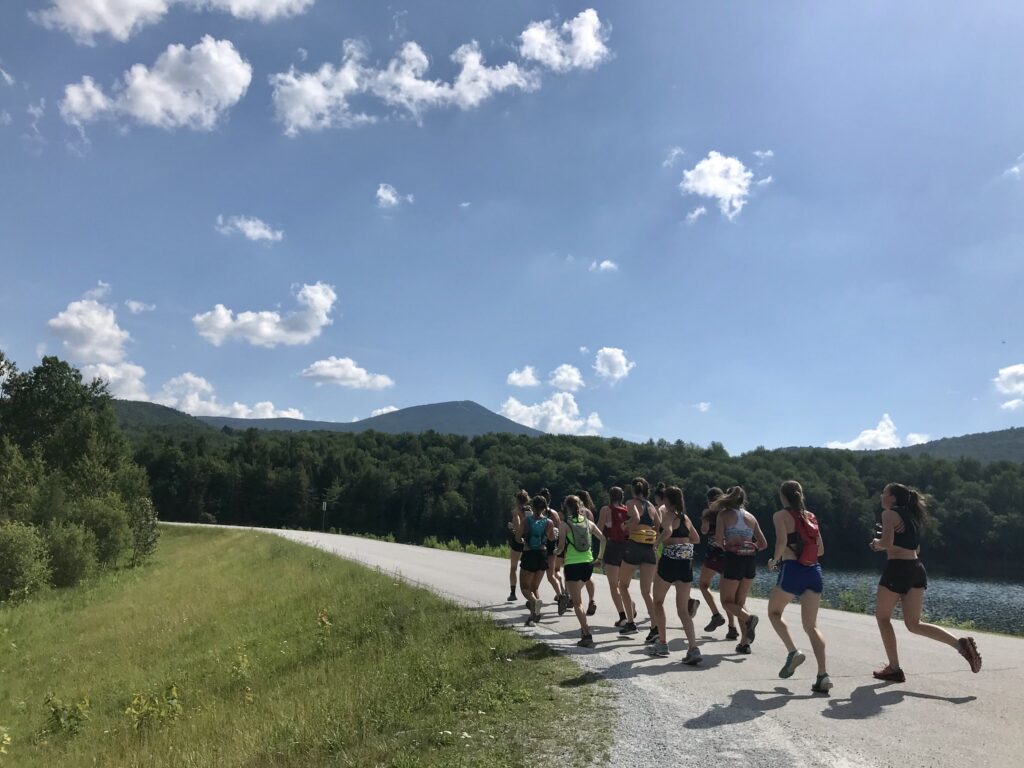
Runners!
Some thoughts on XC running and XC skiing. We are at that time of year again where running is starting up in force and the training might look a bit different than what we’ve been up to at MNC sessions. I wanted to share a couple thoughts and things to keep in mind.
I’m also linking this article from Andy Newell that I believe I shared with some runners last year. I wish this article went a little more in depth on a few topics, which is maybe why I’m feeling compelled to write this post.
I’ll try to break it out in bullet points so this is easier to to digest:
1) Base and peaking
I remember the very first time I was taught this it came from Kasie Enman at a CVU Nordic team pre-season meeting in one of those basement classrooms that may or may not still exist.
Her analogy was simple: picture your year like a triangle or a pyramid. The base of the pyramid is wide, and the blocks are big and more square. That’s the L1 and distance training we do all summer: the base that helps us be able to handle all the hard stuff later.
As the season goes on and we get closer to big races, we get higher on the pyramid. The total time drops, and many of the workouts are harder. The blocks are smaller and they’re more pointy…of course, the very top of the pyramid is the sharpest part! That’s the last Eastern Cup/States/Junior Nationals/etc.
The hardest part about XC season is that you get to school and you have a very limited time before the races. In the month of September, you’re suddenly very high up and on the narrow, pointy part of the pyramid even if you may not have climbed up there yet with training…our ski training is all based off being at that top part in February and March, so while we have done 3kms and running workouts, we haven’t done the hardest and sharpest blocks yet. It’s important to make sure we are still incorporating workouts where we have a higher total training load, particularly of easy distance. It’s also important to maintain our ski-specific strength. I’ll go into both of these now.
2) Pacing, racing, volume
We made a concerted effort to work on run pacing this spring and summer. The downside was that many of these workouts were pretty sparsely-attended, as it’s most easy to do a running workout on-your-own. The goal of paying attention to pace was to gradually build into running by taking miles a bit faster than we usually do to both increase efficiency and to be able to run harder in intervals and timetrials without being as sore.
That 20 mile run we did the other week averaged 10:30 or so, and aside from a couple of miles on steep trails at Cochrans we were pretty much running under 10:00 on any dirt or paved roads. We were still able to talk to one another, but we weren’t lollygagging. That’s a really reasonable distance pace and I’d say for any run longer than 6 miles or so none of us really need to be running faster than 8:00/mi, and even that is what I’d consider the quick end.
If 7:00/mi pace is about a 21:00 5km and your PR is around 20:00, it means that by running close to 7s on a distance training day you are really just coming close to a race-pace effort. Doing that day-in and day-out means the line between easy and hard starts to get blurred…and if you can’t recover from your hard run days, your easy days will suffer and it will become a tough cycle to break out of. A lot of times this cycle is only broken by overuse injury or burnout 🙁
My biggest biggest BIGGEST ask of all XC runners this season is to take those easy runs easy. Don’t get sucked into a competitive mentality on the easy days, and use those days to keep the breathing controlled and the body safe from shin splints, hip strain, and stress fractures. Run the interval days like you want to kick the competition’s butt, and you will. Crush those mile splits on the hard days and end the workout kneeling on the ground in agony…but on the easy days, keep an eye on your pace. If it’s not a pace you could keep up for 90-120 minutes, it’s probably too fast for an easy run, even if that easy run is just 45 minutes. This is the most difficult thing to do but possibly the most important thing you can do to keep yourself in the game from September to March.
3) Cross training and off days
Here’s a rough outline of de-training timelines:
2 weeks muscular strength
3 weeks anerobic and aerobic intensity
4 weeks aerobic capacity
In simplest terms:
-It takes 2 weeks for your strength to begin fading. That’s stuff like pullups, double pole strength, hop-skate power, that sort of thing.
-It takes 3 weeks for things like “race fitness” (how well you can race or do intervals) to begin fading
-It takes 4 weeks for your general capacity (how well you can just go for an easy workout) to begin fading
With XC running, you aren’t going to need to worry about those second two training elements! But upper body strength is huge in skiing. Andy’s article makes a really simple ask: get out for one skate workout and one double-pole-only workout per week. Why is that hard for those in a HS running situation? You often don’t have the flexibility to miss a running day for a ski day, and you almost definitely can’t take TWO running practice days to do ski workouts.
You also need to be taking one off day per week. No training whatsoever. That applies to ALL of us, not just those running XC. So to add to this puzzle, you can’t just utilize your “off” day from XC practice to do a rollerski workout. This is complicated and I sympathize with the chaos of it all. Always feel free to reach out to me if you have questions about a certain day or week.
If you only can realistically fit one ski workout in per week, make it double poling as opposed to skating. So how can this fit in? One option may be to wake up a bit early and do a little double poling before school. It’s tough to motivate for but not the worst idea. Maybe there is even a good rollerski place near your school? BHS has it easy in this regard with the bike path right there!
You could also finish up a shorter XC practice day with a double pole after. In most cases, you only need to get out for about 45 minutes for a specific workout to have an impact, and that includes double poling. If you only have 30 minutes, you can still make it work by incorporating a bit of single-stick…think of it like a mini booster workout where you fit as much quality upper body work as you can into half an hour.
A final option is the “floor gym” as I sometimes call it. Pushups, chair dips, core, and bodyweight exercises. Stuff that will keep your upper body engaged even if it isn’t ski specific!
4) Coach communication
A lot of this information, and a lot of these workouts, can get dicey when there isn’t good communication. I am not advocating anyone barge out of an XC practice because “Coach Adam told me I have to rollerski this day” and likewise I am fully aware (and encourage) athletes to take the day off from ski training if they are feeling tired from running. EVEN IF it’s the one day a week you might get to spend with MNC. If you’re tired and unmotivated, it probably means you need a break. Use that MNC day as a rest day and it’ll mean more than grinding out some ski work on less than 100% energy.
Talk to your XC coaches early and often about what your plans are. Use the MNC training doc to look ahead and coordinate days which make sense to attend both from a training and running schedule perspective. And don’t hesitate to reach out with questions, concerns, or just general thoughts on what you might like to do in a given week!





Comments are closed.